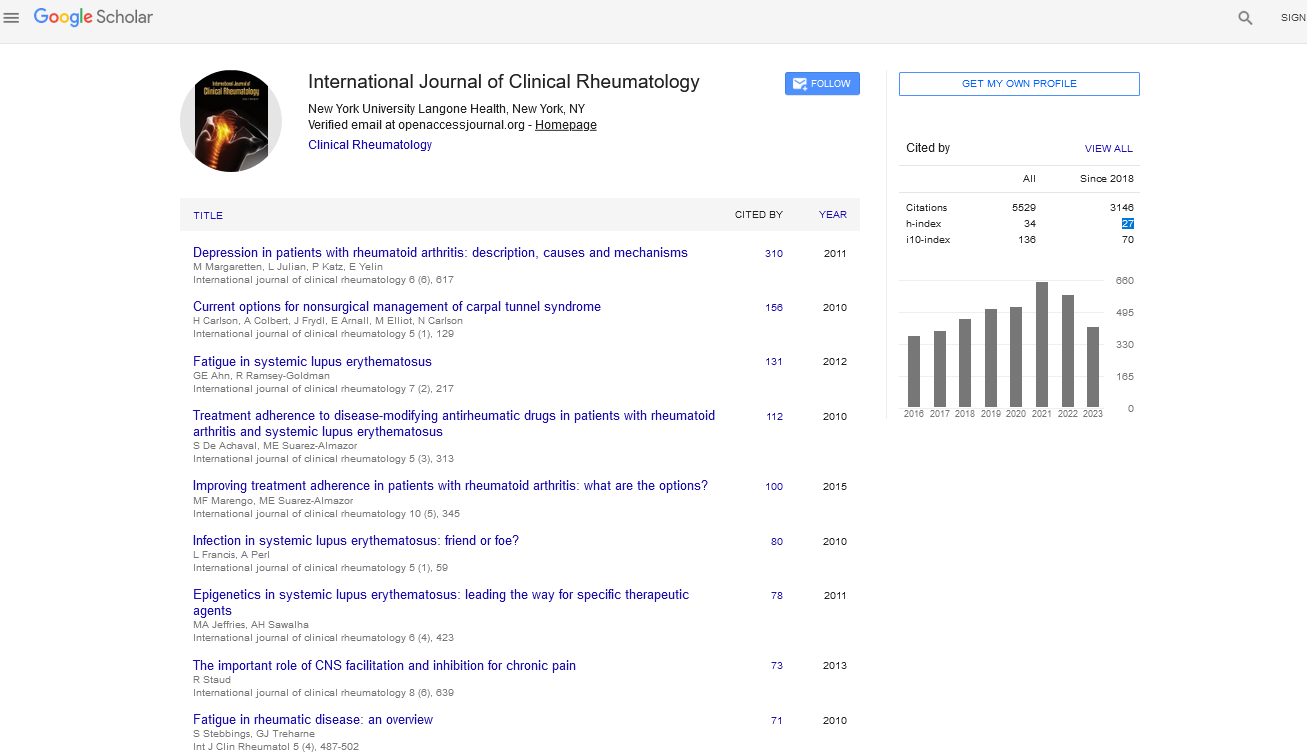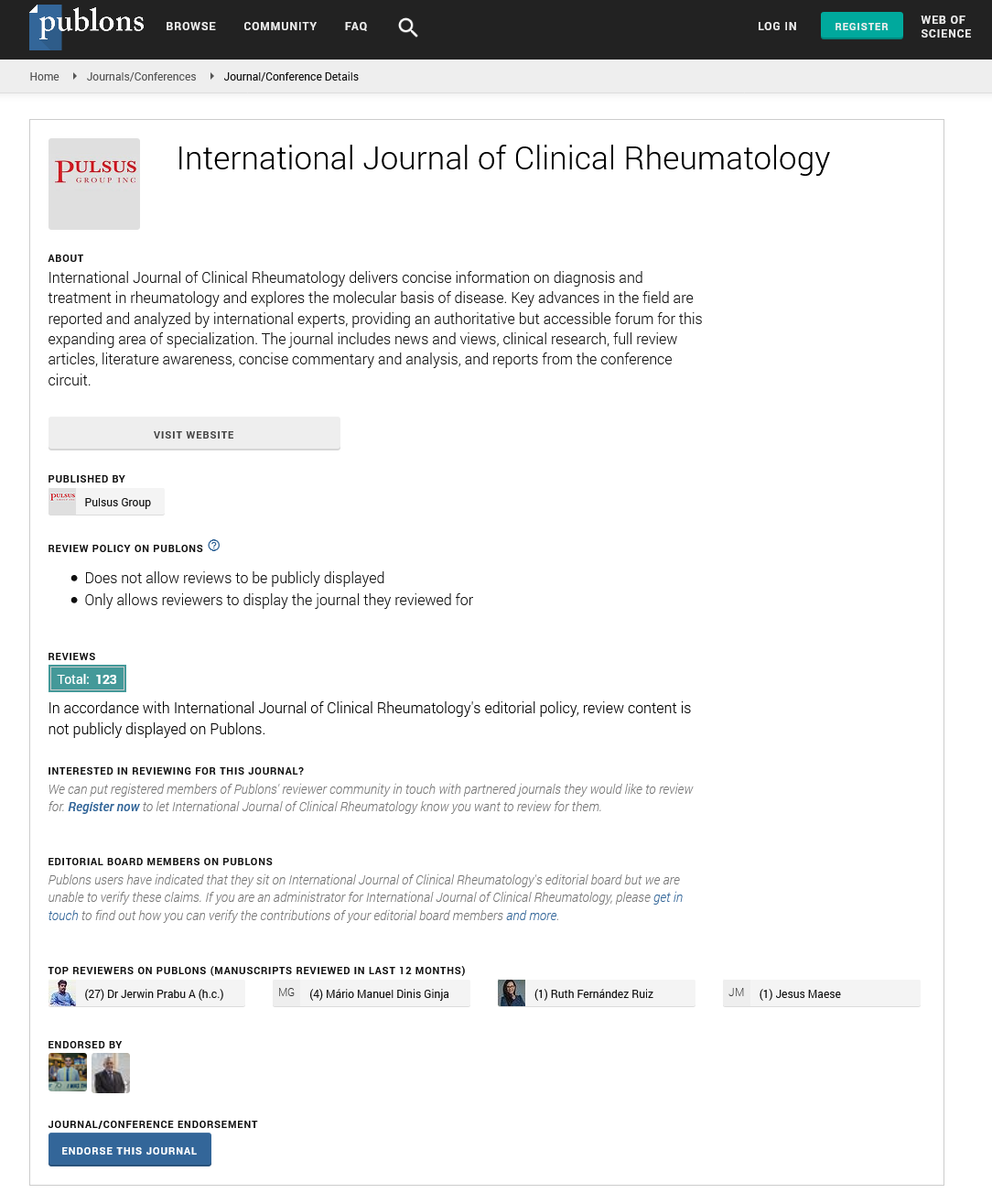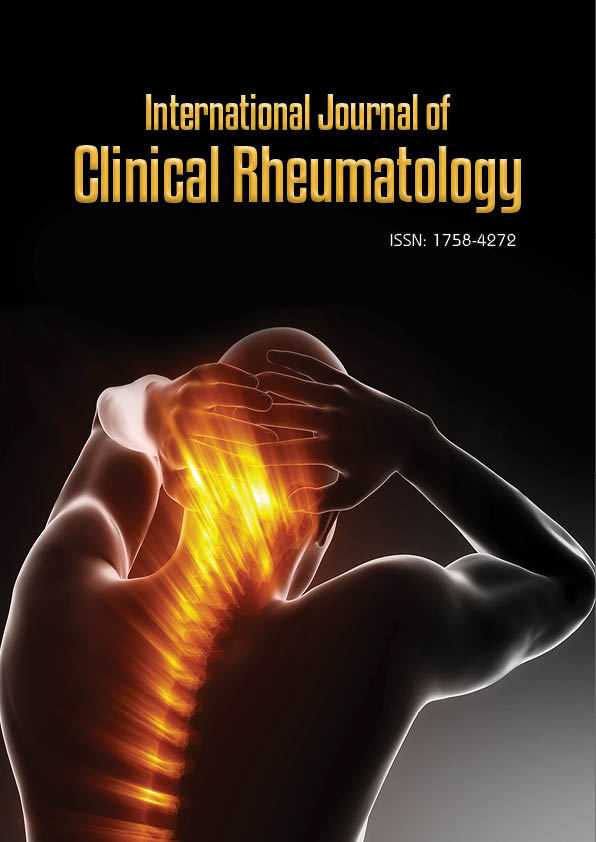Perspective - International Journal of Clinical Rheumatology (2025) Volume 20, Issue 2
Cardiovascular Risk during Rheumatoid Arthritis (RA), in the Rheumatology Department of Cocody University Hospital (Abidjan)
Mamoudou Taganga S*, Gbane Mariam, Coulibaly Abidou, Djaha Kouassi JM, Diomande Mohamed, Baly Ouattara, Eti Edmond
Department of Cardiology, Benson Idahosa University, Benin, Nigeria
- *Corresponding Author:
- Mamoudou Taganga S
Department of Cardiology, Benson Idahosa University, Benin, Nigeria
E-mail: mamoudou.salifou@icloud.com
Received: 24-Nov-2024, Manuscript No. FMIJCR-23-121055; Editor assigned: 27-Nov-2024, Pre-QC No. FMIJCR-23-121055 (PQ); Reviewed: 11-Dec-2024, QC No. FMIJCR-23-121055; Revised: 17-Feb-2025, Manuscript No. FMIJCR-23-121055 (R); Published: 24-Feb-2025, DOI: 10.37532/1758-4272.2025.20(2).414-415
Introduction
Rheumatoid Arthritis (RA), a chronic inflammatory disease, is associated with a significantly increased rate of cardiovascular disease.
Cardiovascular events occur in RA patients approximately 10 years earlier than in the general population.
The importance of cardiovascular risk in RA can be measured by several composite tools, the most advanced of which is the QRISK3 Score.
The aim of our study is to study this cardiovascular risk in patients with RA, through QRISK3 and a specific mathematical model.
This study, with descriptive and analytical aims, carried out in the rheumatology department of Cocody University hospital (Abidjan) collecting 50 patients with RA and meeting the ACR 1987 and/or ACR/ EULAR 2010 classification criteria. We studied the following Cardiovascular risk factors (CVD): Age (over 55 years in women and over 50 years in men), male sex, smoking, high blood pressure (hypertension), diabetes, dyslipidemia, alcohol, high DAS 28, ACPA positivity, long term corticosteroid therapy. We have also provided operational definitions of QRISK 3 and our mathematical assessment of cardiovascular risk based on the epidemiology of Cote d’Ivoire (annual death rate, death rate linked to cardiovascular conditions, data from linked mathematical models to cardiovascular risk in various regions of the world) helped by a mathematician specializing in differential equations.
The sex ratio (M/F) was 0.086.
The average age was 44.96 years (17-82).
The average progression time was 107.4 years. Cardiovascular risk factors associated with RA were:
• Age over 55 years for women (34%)
• Age over 50 years in men (2%)
• Hypertension (30%)
• Male (8%)
• Alcohol (10%)
• Type 2-diabetes (8%)
• Smoking (4%)
• High DAS 28 (84%)
• Long term corticosteroid therapy (100%)
The risk of major cardiovascular events was low to moderate in 49 patients (98%) according to QRISK3. According to our mathematical model, 37 patients (74%) had a low to moderate risk of death at 10 years from cardiovascular events and 13 patients (26%) had a high to very high risk.
With the Pearson Chi-square test, there was a statistically significant link between:
• Hypertension and CRP (CI: 95%, P=0.00).
• Diabetes and a long time to progression (CI: 95%, P=0.0015).
• Diabetes and the civil servant profession (CI: 95%, P=0.0046).
• Smoking and a long time to progression (CI: 95%, P=0.0061).
• Alcohol consumption and civil servant profession (CI: 95%, P=0.0127).
• CRP and joint destruction on the one hand and cardiovascular risk calculated according to QRISK3 on the other hand.
• CRP and joint destruction on the one hand and the risk of death from cardiovascular origin calculated using our mathematical model on the other hand.
Description
According to the EULAR recommendations on cardiovascular risks in inflammatory rheumatism, RA must be considered as a CV risk factor in its own right. This increase in risk is linked to classic cardiovascular risk factors and factors specific to RA; RA ultimately being, in itself, an independent cardiovascular risk factor, like diabetes (inflammation (even low) being the bedrock of this now established characteristic).
The classic tools for calculating (absolute) cardiovascular risk are applicable to patients with RA and among these the QRISK3 seemed particularly interesting to us; but it offers limitations linked to its design ecosystem (established for the British population first); it then seemed interesting to us to establish a mathematical model based on the epidemiology and medical realities of our study population, in order to consider an autonomous, efficient tool for assessing cardiovascular risk within it and subsequently to have an effective intervention to reduce or control this risk.
In our study the link between inflammation (and disease activity) and increased cardiovascular risk was clearly established, in accordance with literature data.
Likewise a clear concordance in the pure mathematical domain, between our mathematical model (which evaluates the risk of death at 10 per cardiovascular event) and the QRISK (which evaluates the risk of occurrence of a cardiovascular condition).
Conclusion
In addition to classic CVRF’s, RA itself is described as an independent cardiovascular risk factor. Better control of activity is necessary for lower CV risk.
Tools for assessing cardiovascular risk must be established and perfected for daily use and an improvement in the quality of life and longevity of patients with RA, in an integrated approach, based on tight control and treat to target.


